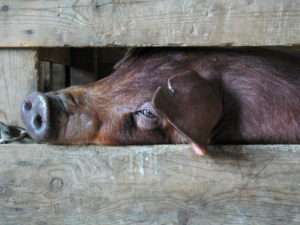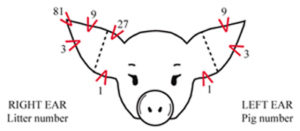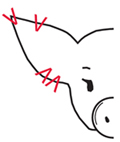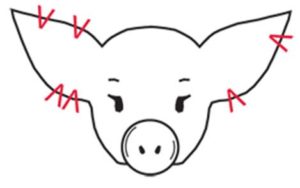Main Content

The Universal Ear-Notching System used to identify individual pigs in a litter has been around for.., a while.., but finding the actual historical roots of the how and why this system originated has proven elusive. What was found is not altogether that informative, nor does it come from any legitimate primary source. As of this writing, the best guess at the history of the ear-notching system is that it most likely was introduced by a purebred registry association, possibly sometime in the 1920s. (But this writer encourages those out there reading this to do some fact-checking/offer some real evidence into the origins of ear-notching!)
What is known about universal ear-notching is, well, universal!
While the ear-notching system provides an inexpensive way to identify individual swine and has been around for a great long while (but exactly how long is, again, at present, a mystery), it is nevertheless a system that some of those exhibiting swine projects may find difficult to understand.
So, let us break things down, one ear at a time!
We will first start with the right ear (which, it is important to note, is the right ear of the animal, not necessarily the ear that is to the right when looking at the animal).
The right ear is the ear used for the litter number. There are five locations for notches on this ear, and each location is assigned a number. Those five numbers are: 1, 3, 81, 9, or 27. Figure 1 below shows where each notch may be located.

The left ear (again, the left ear of the animal, not necessarily the ear that is on the left according to the observer) is number of the piglet. There are three locations for notches on the left ear, and each notch is assigned a number. Those three numbers are: 1, 3, and 9. Figure 1 above shows where each notch may be located.
If all of the above was “TLDR”; the litter number is noted in the pig’s right ear and the individual pig number is noted in the pig’s left ear.
With this system in place, though it is possible (and, in fact, expected) that every pig in the same litter should have the same notches on their right ears, the notches on the left are as individual as the piglet.
Let us go back to the right ear, and working from Figure 2 below, determine what the litter number is.

Using the handy-dandy Figure 1 as our guide, we know the four notches above are: 1, 1, 9, and 81.
We then add those numbers together to determine the litter number.
Litter Number = 1 + 1 + 9 + 81 = 92
The litter number for Figure 2 is 92.
With the litter number figured out, let us now move onto the left ear, and determine what the individual pig number is working with Figure 3.

To review, we first go back to Figure 1. Using that as our guide, we know the four notches in Figure 3 are: 1, 1, 3, and 9.
We then add those numbers together to determine the individual number.
Individual number = 1 + 1 + 3 + 9 = 14
The individual number is 14.
Now, let’s take everything we’ve learned, and put it together.

Right ear = 1, 1, 9, 27
Thus: 1 + 1 + 9 + 27 = 38
Left ear = 1, 3
Thus: 1 + 3 = 4
The pig in Figure 4 is identified as 38-4.
So, why is any of this even necessary? Ear notching is a permanent method of pig identification. Whereas ear tags may be lost or damaged, ear notching remains in place to provide a unique identification for each animal. Be it for a 4-H project or for commercial purposes, it benefits anyone involved in the swine industry to have a handle on the Universal Ear-Notching System. (Now.., if we can just figure out how this whole thing started! But, that is a blog for another day.)
For more information on the Universal Ear-Notching System, read this publication from the University of Nebraska Extension.
By Matthew Newman, Monmouth County 4-H Agent, Rutgers Cooperative Extension